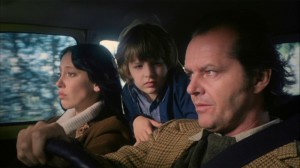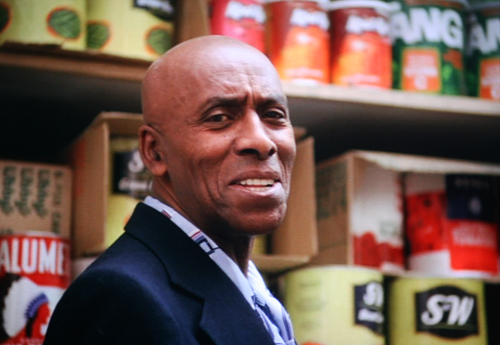The Shining part 3: Closing Day
At the beginning of The Shining‘s second section, “Closing Day,” it’s almost like the movie begins again: here are more overhead shots of the yellow VW winding its way up an isolated mountain road. What’s different? Well, this time the car is going around the right side of the mountain instead of the left side.
Much has been written, some of it quite intelligent, about the spatial anomalies and inconsistencies in The Shining: there are rooms with windows that should not be there and doors that couldn’t possibly lead to anywhere, rooms appear to be in one place in one scene and another place in another, wall fixtures and furniture pieces appear and disappear from scene to scene, props move from one room to another, and the layout of the Overlook makes no physical sense. To name only obvious example, the establishing shots of the hotel, which is a real hotel in Oregon, show no gigantic hedge maze off to one side. For myself, I have a rule — if the filmmakers don’t point at it, I’m not supposed to notice it. I think that, beyond presenting a vague sense of disorientation, all the inconsistencies and conundrums are simple continuity problems. Kubrick shot and assembled the movie over a period of months and the production design was meant to serve each scene as a separate entity, he wasn’t worrying about whether the architectural details would all line up. For instance, when Jack enters Room 237, the room bends away to the left. But in the hallway outside, there are doorways to other rooms where the bedroom and bathroom of Room 237 should be. I don’t think this is a deliberate mystery, I think Kubrick wanted the room to look one way and the hallway to look another way, and didn’t worry about whether the two set designs matched up. In the case of the road now being on the other side of the mountain, my guess is that Kubrick shot the scene in the car, which features Jack in the foreground, the camera placement necessitated mountain vistas being visible in the background process plate, which necessitated establishing shots of the car going up the right side of the mountain.
And yet, the “Closing Day” section is designed to one overwhelming purpose: to establish The Overlook as a character in and of itself. Because, as I’ve mentioned earlier, the hotel is the protagonist of the narrative.
So the car winds its way up the (other) side of the mountain. Unlike the title-sequence car trip, this time we do go inside the car, and see how things are with the Torrance family. What are the Torrances talking about? Three things. One, “we’re really up high here,” indicating that they’re leaving civilization long behind and heading to a rarefied, isolated existence. Two, there’s some discussion about Danny being hungry, which allows Jack to verbally punish his son (“You should’ve eaten your breakfast”). Three, a discussion of the Donner Party and its attendant cannibalism. So: we’re really high up, Danny’s hungry, and cannibalism is a viable option. Jack, for his part, looks like he can’t wait to do a little cannibalizing — he literally licks his lips at the mention of it. Wendy is scandalized by Jack’s making light of the most taboo of taboos, but Danny talks her down by saying “It’s okay, I know all about cannibalism, I saw it on TV.” Again, evil is made common, even domestic, even boring, through a banal cultural presentation.
Mr. Ullman gives Jack and Wendy a tour of the hotel while Danny is spooked by visions of dead girls in the games room. All around Jack and Wendy, employees flee like rats from a sinking ship. The tour of the hotel serves a couple of functions. One, it serves as a kind of tour of Act III, telling us things like “This isn’t weird, this is just a hedge maze, perfectly common, nothing evil or mysterious about it, nothing evil could happen here.” Two, again, it draws us into this huge labyrinth of a building — which is what I mean about the rooms not lining up. I think Kubrick means to deliberately disorient us, to present a place whose layout seems to change every time we move through it. There can be no escape from a labyrinth with mutable walls.
While Danny sees the two girls in the games room, Jack sees a different pair of girls in the hall while Ullman shows Jack and Wendy their apartment. Two young hotel employees head down the stairs as Ullman shows Wendy inside, and Jack lingers to gaze upon the women as they sashay away. As Jack mentioned before, he’s “looking for a change.” And the hotel, he surmises, is a hotbed of young, available women. This surmise will have a disastrous payoff in Act II.
Ullman shows Jack and Wendy the hedge maze — another part of the tour of Act III — and mentions that the hotel was built on an “Indian burial ground.” This is a bit of gothic hokum too cliched to be taken seriously. Or is it? There are a number of lines and references that suggest that The Overlook is a metaphor for the United States, a beautiful place built on slaughter and enslavement. (Speaking of which, Ullman tells Jack about the Grady massacre at his interview, almost as an afterthought. I’ve always wondered, what was he going to do if Jack freaked out then and there? Does he have a backup candidate in mind? But of course, that’s why he had the silent Bill Watson come in for the meeting, to make sure Jack didn’t freak out.)
Ullman then shows Jack and Wendy their crappy little apartment. Both are clearly disappointed with it — five months of being in this cell would be murder, it’s worse than the dump they had down in Boulder — but Jack puts on a shit-eating grin and says “homey.” He is, obviously, a man seething with rage.
In The Gold Room, Jack makes a point of declaring “We don’t drink,” in that conversation-stopping manner that screams “I AM A WHITE-KNUCKLE DRY DRUNK.” At this point into my understanding of The Shining (a movie I’ve seen at least once a year since it was released in 1980), I’m a little disappointed with Jack’s alcoholism. It’s too easy, too convenient a wedge into his madness, “the demon in the bottle” and so forth. It seems to me that Jack can still have a violent temper and an antic manner without also being an alcoholic.
The visit to The Gold Room brings Danny back to his family. “You get done bombing the universe?” asks Jack, which strikes me as one of the few dated references in the movie: video games, limited to arcades, were a new, scary influence on kids back then. The games room of The Overlook has none on display, and Danny is playing darts anyway when he sees the twin girls, so Jack’s remark serves two purposes — it shows how out-of-touch he is with his son, and it shows where his sympathies lie: if he were in Danny’s place, he wouldn’t be playing darts in the games room, he’d be bombing the universe.
What does Dick Halloran want? He takes Wendy and Danny on a tour of the kitchen. Wendy is stunned and disoriented by the vastness of the space, but Halloran assures them that there is nothing special about the place — rather, it is an ordinary kitchen, and a cornucopia at that. So we would say that Halloran’s motivation is “to calm.” And yet, his long lists of everything available in the Overlook kitchen do the opposite of calm, they begin to terrify — so much food, so much choice, so many plants and animals have been sacrificed for the Torrance’s comfort. For years I was baffled by the scene in the meat locker, I didn’t understand why it was in the movie. Now I see that it ties to the very end — Jack, too, ends up a frozen carcass, feeding the hotel.
Dick Halloran gets Danny alone, which is his goal from the moment he meets him. Their scene together is gorgeous. Halloran starts out by giving Danny a gentle, folksy interrogation. Danny knows something that Halloran wants him to reveal — namely, his psychic power, his “shine.” Again, Halloran’s task is to placate, to reassure — nothing bad is going on here, this is all perfectly normal, there’s nothing to be afraid of. Which makes it all the more beautiful when Danny turns the tables on him. He reveals that it’s Halloran who’s really afraid of the Overlook. Halloran tries to shrug off Danny’s questions with an aw-shucks dismissal, but he gives himself away, he’s clearly terrified.




That’s one thing that confuses me about Halloran’s character: Why does he keep working at The Overlook? He knows the hotel’s evil, so why not get the Hell out of there? Or at least why not tell Danny that he should get the Hell out of there as well? If we’re to assume that Halloran’s there to help, then why does he downplay The Overlook’s threat? Maybe he was also a former caretaker.